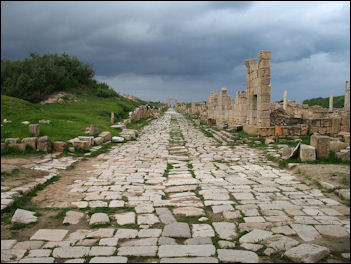CITIES AND TOWNS IN THE ROMAN EMPIRE
Leptis Magna in Libya In addition to being great architects, the Romans were also unsurpassed city planners. With the exception of Rome itself, which had already evolved into a confused mess before Roman planners got a hold of it, Roman cities were laid out in grids with crossing streets, great boulevards, open circle and squares and carefully placed parks, temples and civic centers. Many cities and towns in Europe were founded by the Romans. Cities that got their start as Roman camps (castra) and still have the word in their names include Lancaster, Manchester and Worcester.
Roman cities were neatly laid out in a grid pattern, in many cases with wide streets at right angles to one another, and “every fifth street and avenue of unusual breadth." The buildings had strong foundations and numerous inscriptions with angular Roman letters. Remnants of Roman cities can be found in almost every major population center in southern Europe, Turkey, Syria and North Africa and many places in Spain, France, Switzerland, Britain, Romania and Bulgaria.
A Roman town was not considered a proper town unless it had paved streets, baths, a reliable water supply (often from an aqueduct). The public baths were generally open to everyone rich or poor. Most important cites were surrounded by protective walls and featured a triumphant gateway, colorful mosaic sidewalks, an amphitheater, smaller theaters, a hippodrome (horse track), paved streets. marble meeting halls for the local council, temples honoring Roman and local gods, and a market place with colonnades, often surrounding a fountain.
The towns of the empire were in their general appearance reflections of the capital city on the Tiber. Each town had its forum, its temples, its courthouse (basilica) and its places of entertainment, Its government seemed to be copied after the old city government of Rome. It had its magistrates, chief among whom were two men (duumviri), something like the old consuls. It had its municipal council or senate (curia), controlled by a municipal aristocracy (curiales). Its people delighted in the same kind of shows and amusements that we have seen at Rome. A typical small city was laid out in a grid pattern with a centrally-located market, bath complexes, a library and a theater that could seat 3,500. [Source: “Outlines of Roman History” by William C. Morey, Ph.D., D.C.L. New York, American Book Company (1901), forumromanum.org \~]

At Pompeii we find in the graffiti, or writings left upon the walls of buildings, some remarkable evidences of the ordinary life of the townsmen. Some of these writings hardly rise above the dignity of mere scribblings. They are most numerous upon the buildings in those places frequented by the crowds. There we find advertisements of public shows, memoranda of sales, cookery receipts, personal lampoons, love effusions, and hundreds of similar records of the common life of this ancient people.
If we should attempt to draw a distinction among the various towns of the empire, we might observe that the people of the Western towns became more Romanized than those of the Eastern towns. The Latin language prevailed in the West, and the Greek language in the East. But still the Latin was used as the official language in the East as well as in the West; and, on the other hand, the knowledge of the Greek was a mark of culture in the West as in the East. \~\
Categories with related articles in this website: Early Ancient Roman History (34 articles) factsanddetails.com; Later Ancient Roman History (33 articles) factsanddetails.com; Ancient Roman Life (39 articles) factsanddetails.com; Ancient Greek and Roman Religion and Myths (35 articles) factsanddetails.com; Ancient Roman Art and Culture (33 articles) factsanddetails.com; Ancient Roman Government, Military, Infrastructure and Economics (42 articles) factsanddetails.com; Ancient Greek and Roman Philosophy and Science (33 articles) factsanddetails.com; Ancient Persian, Arabian, Phoenician and Near East Cultures (26 articles) factsanddetails.com
Websites on Ancient Rome: Internet Ancient History Sourcebook: Rome sourcebooks.fordham.edu ; Internet Ancient History Sourcebook: Late Antiquity sourcebooks.fordham.edu ; Forum Romanum forumromanum.org ;
“Outlines of Roman History” forumromanum.org; “The Private Life of the Romans” forumromanum.org|; BBC Ancient Rome bbc.co.uk/history; Perseus Project - Tufts University; perseus.tufts.edu ; Lacus Curtius penelope.uchicago.edu;
Gutenberg.org gutenberg.org
The Roman Empire in the 1st Century pbs.org/empires/romans;
The Internet Classics Archive classics.mit.edu ;
Bryn Mawr Classical Review bmcr.brynmawr.edu;
De Imperatoribus Romanis: An Online Encyclopedia of Roman Emperors roman-emperors.org;
British Museum ancientgreece.co.uk; Oxford Classical Art Research Center: The Beazley Archive beazley.ox.ac.uk ;
Metropolitan Museum of Art metmuseum.org/about-the-met/curatorial-departments/greek-and-roman-art;
The Internet Classics Archive kchanson.com ;
Cambridge Classics External Gateway to Humanities Resources web.archive.org/web; Internet Encyclopedia of Philosophy iep.utm.edu;
Stanford Encyclopedia of Philosophy plato.stanford.edu;
Ancient Rome resources for students from the Courtenay Middle School Library web.archive.org ;
History of ancient Rome OpenCourseWare from the University of Notre Dame /web.archive.org ;
United Nations of Roma Victrix (UNRV) History unrv.com
Books: “The Fires of Vesuvius, Pompeii Lost and Found” by Mary Beard (Belknap Press/ Harvard University, 2009); “Daily Life in Ancient Rome” by Florence Dupont; Life and “Letters on the Roman Frontier: Vindolanda and Its People” by Alen K. Bowman and J. David Thomas (British Museum Press, 1994).
Town Life
Harold Whetstone Johnston wrote in “The Private Life of the Romans”: “Little is told us in literature about the life of the country towns (municipia). This is the more remarkable because most of the great writers were not Roman-born but came from the municipia of Italy or the provinces. Most of our information is derived from the inscriptions that the citizens of these towns have left behind them, and from the excavations. These remains, dating chiefly from the Imperial Age, may be studied not merely in Italy but in all the provinces. [Source: “The Private Life of the Romans” by Harold Whetstone Johnston, Revised by Mary Johnston, Scott, Foresman and Company (1903, 1932) forumromanum.org |+|]
“At all times the man who was Roman-born looked down on the country towns and their people. The satirists indeed contrast the quiet simplicity of the municipality with the turmoil and vice of cosmopolitan Rome. But then, as now, many preferred the complexity and excitement of the great city with all its discomforts to the greater amount of comfort that their incomes would have brought them in a town.|+|
“Property of course was cheaper and rents were lower in the small town. It was possible to live there in a comfortable house on an income that provided only a cramped lodging in one of the great insulae of the city. Tunic and sandals could be worn instead of the heavy and expensive toga and shoes (calcei). The range of interests in the small town was narrower, often intensely local. To the energetic and generous citizen this local interest and civic pride offered an outlet, and that it was a welcome one is shown by the keen competition for local honors until a late period of the Empire.” |+|
Local Government

Harold Whetstone Johnston wrote in “The Private Life of the Romans”: “The towns were for the most part self-governing. The charters of some of them have been found. The magistrates were elected by popular vote, and the election notices painted on the walls at Pompeii show that all classes took a lively interest in the elections. This does not mean that the spirit of the municipalities was democratic. [Source: “The Private Life of the Romans” by Harold Whetstone Johnston, Revised by Mary Johnston, Scott, Foresman and Company (1903, 1932) forumromanum.org |+|]
“The classes were divided by clearly-drawn lines. The candidates for office must come from those who were eligible for membership in the town council (curia); for this there was a property qualification. They must be free-born and of good reputation and not engaged in any disreputable business. No salaries were attached to the offices, however. Indeed, each magistrate was expected to pay a fee (honorarium) on his election, and to make substantial gifts for the benefit of the citizens and the beautifying of the town. Like the great magistrates at Rome they were entitled to the toga praetexta, the curule chair, the attendance of lictors, and special seats at the games.
“Town Council. The curia, or town council, usually consisted of one hundred members (decuriones), including the ex-magistrates. They had to be of a certain age, at least twenty-five; they had to possess the required amount of property, and be free-born. They were entitled to the best places at the games and to the bisellia. Apparently they used the city water free of charge, and at any public entertainment or distribution of money they were entitled to a larger share than the common people. Each probably paid a fee on his admission to the curia and was expected to make generous gifts of some sort for the benefit of his city. |+|
Townspeople in the Roman Empire
Harold Whetstone Johnston wrote in “The Private Life of the Romans”: “Equites. Members of the equestrian order made up the aristocracy of the municipia as the “nobles” did at Rome. Conspicuous among them were the retired army officers, occasionally tribunes, but more often the centurions who were sometimes retired with equestrian rank, particularly the primipilarii, or men who had attained the chief centurionship of their legions. Such a man might come back to cut a big figure in his home town (patria), or might settle in the province where he had seen service. In either case inscriptions often survive to tell us of his war record and his benefactions to his native town. [Source: “The Private Life of the Romans” by Harold Whetstone Johnston, Revised by Mary Johnston, Scott, Foresman and Company (1903, 1932) forumromanum.org |+|]|

“Augustales. Below and apart from these were rated the wealthy freedmen. Ineligible for office and council as they were, a special distinction and an opportunity for service and generosity were provided for them in the institution of the Augustales, a college of priests in charge first of the worship of Augustus and then of the following emperors. Each year the decuriones selected a board of six (seviri) to act for that year. At the public ceremonies of which they were in charge they were entitled to wear a gold ring like that of the equites and the bordered toga. They paid a fee on election, provided the necessary sacrifices, and proudly rivaled the decuriones in gifts to the community. |+|
“Plebs. Then came the plebs, the citizens not entitled to serve in the council, and below them the poor freedmen. These were the men who kept or worked in the small shops and made up the membership of the many guilds of which we find traces at Pompeii and which must have been very much the same in other cities. However hard their work and simple their fare, they could not have found their life mere drudgery. They expected the magistrates to see to it that bread and oil, the two great necessities of life, were abundant and cheap in the markets. They also expected them to furnish entertainment in the shape of games in the amphitheater and theater and of feasts as well. Even small towns had their public baths, where the fee was always low, and was sometimes remitted for longer or shorter periods by the generosity of wealthy citizens.” |+|
Public Buildings in Roman Towns
Harold Whetstone Johnston wrote in “The Private Life of the Romans”: “In its baths, theater, and amphitheater, fora, basilicas, paved streets, bridges, aqueducts, arches, and statues, each town was modeled upon Rome. Domestic architecture varied. The Roman houses in Britain and Africa are not of the type that we find at Pompeii. But in public buildings and public works the towns were Roman—as can be easily seen wherever their remains are found. Some of the most striking examples are in Africa, where in the Imperial Age the Romans maintained thriving towns in regions that are desert now. [Source: “The Private Life of the Romans” by Harold Whetstone Johnston, Revised by Mary Johnston, Scott, Foresman and Company (1903, 1932) forumromanum.org |+|]

street in Ostia
“The strong civic pride of each town and the keen rivalry between neighboring towns expressed itself particularly in handsome buildings and in public works. It has often been said that at no other time in the world were there so many beautiful towns as there were in the Roman Empire during the third century of our era. Yet this does not mean that municipal taxation was heavy or that the revenues from lands and other city property paid for all these works. Much was expected from the generosity of the official class, and much was received. Others, women as well as men, gave liberally. The amphitheater at Pompeii was given by two men who had held high office in the city. A very lively and distinguished old lady, Ummidia Quadratilla, gave a temple and amphitheater at Casinum. Among the gifts of Pliny the Younger to his native town was a library with funds for its maintenance. The dedication of such a building was often celebrated by the donor with a feast for the community, where the citizens shared according to their rank. Inscriptions regularly commemorated such gifts. Sometimes in appreciation of his generosity the curia voted a citizen a statue of honor; sometimes he paid for the statue, too!
“Schools. But the municipalities did not show the large and elaborate school buildings conspicuous in our towns now, nor were there likely to be school taxes. Until a very late period education remained generally a private matter. There were occasional endowments from the wealthy for educational purposes, as, more often, for other charitable foundations. Elementary schools must have been established in the Italian towns and throughout the provinces generally with the spread of Roman influence. The more advanced schools would naturally be found only in the larger towns and cities. At the beginning of the second century of our era Pliny the Younger tells of contributing largely to a fund to open a school in his native town of Comum, that the boys might not have to go to Mediolanum (Milan). The arguments he uses for the education of the boys at home are very much like those used for the establishment of junior colleges in many of our towns at present. Some boys were sent to Rome for the sake of better schools and more famous teachers than the country and provincial towns afforded. Agricola found the establishment of schools in Britain a useful aid in strengthening the Roman hold on the conquered territory.” |+|
Water Supply in Roman Towns
Some houses had water piped in but most homeowners had to have their water fetched and carried, one of the main duties of household slaves. In large towns the poor must have carried water for household use from the public fountains in the treets, where the water ran constantly for all comers.

aqueduct
Harold Whetstone Johnston wrote in “The Private Life of the Romans”: “Water Supply. All the important towns of Italy and many cities throughout the Roman world had abundant supplies of water brought by aqueducts from hills, sometimes at a considerable distance. The aqueducts of the Romans were among their most stupendous and most successful works of engineering. The first great aqueduct (aqua) at Rome was built in 312 B.C. by the famous censor Appius Claudius. Three more were built during the Republic and at least seven under the Empire, so that ancient Rome was at last supplied by eleven or more aqueducts. Modern Rome is well supplied by four, which are the sources and occasionally the channels of as many of the ancient ones. [Source: “The Private Life of the Romans” by Harold Whetstone Johnston, Revised by Mary Johnston, Scott, Foresman and Company (1903, 1932) forumromanum.org |+|]
“Mains were laid down the middle of the streets, and from these the water was piped into the houses. There was often a tank in the upper part of the house from which the water was distributed as needed. It was not usually carried into many of the rooms, but there was always a fountain in the peristylium and its garden, and a jet in the bathhouse and in the closet. The bathhouse had a separate heating apparatus of its own, which kept the room or rooms at the desired temperature and furnished hot water as required. |+|
“The necessity for drains and sewers was recognized in very early times, the oldest at Rome dating traditionally from the time of the kings. Some of the ancient drains, among them the famous Cloaca Maxima, were in use until recent years.” |+|
Forum and Roman Shopping Malls
The forum was the main square or market place of a Roman city. It was the center of Roman social life and the place where business affairs and judicial proceedings were carried out. Here, orators stood on podiums pontificating about the issues of the days, priests offered sacrifices before the gods, chariot-borne emperors rode past worshipping crowds, and people milled about shopping, gossiping and simply hanging out.

Roman shop
Dr Joanne Berry wrote for the BBC: Pompeii's forum was “the political, commercial and social heart of the town, as in all other Roman towns. As was typical of the time, most of the most important civic buildings at Pompeii - the municipal offices, the basilica (court-house), the principal temples (such as the Capitolium), and the macellum (market) - were located in or around the forum. [Source: Dr Joanne Berry, Pompeii Images, BBC, February 17, 2011 |::|]
“Recent archaeological work has demonstrated that in the years immediately before Vesuvius destroyed Pompeii, building work was taking place to improve the appearance of the forum. Wall-paintings in one of the houses excavated illustrate scenes from the forum, such as bustling market-stalls set up in the colonnade fronting many of the forum buildings. Such evidence highlights the importance of this area in the everyday lives of the town's inhabitants.” |::|
It has been asserted the the Romans invented the shopping mall. Andrew Handley wrote for Listverse: “Trajan’s market was a massive open building in ancient Rome that is probably one of the world’s first examples of something we usually associate with the 20th century—a shopping mall. And while today’s malls probably wouldn’t stand up against even a mediocre hurricane, the Roman building is still standing more than 2,000 years later. [Source: Andrew Handley, Listverse, February 8, 2013]
“The two level building was located in the center of what used to be the main city of Rome, and is large enough to hold roughly 150 different shops. The reason it has weathered so well is because of the innovative way Romans made concrete for their structures—they were one of the first to start mixing lime in with concrete to protect it from corrosion.”
Street Life in the Roman Towns and Cities
Harold Whetstone Johnston wrote in “The Private Life of the Romans”: It is evident from what has been said that a street in a residence quarter of an ordinary Roman town must have been plain and monotonous in appearance. The houses were all of practically one style, they were finished alike in stucco, the windows were few and mainly in the upper stories, there were no lawns or gardens facing the streets; there was, in short, nothing to lend variety or to please the eye, except, perhaps, the decorations of the vestibula, or the occasional balcony (maenianum), or a public fountain. [Source: “The Private Life of the Romans” by Harold Whetstone Johnston, Revised by Mary Johnston, Scott, Foresman and Company (1903, 1932) forumromanum.org |+|]
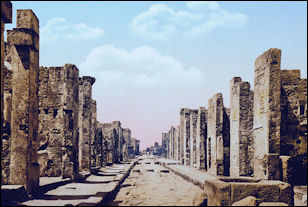
Pompeii street “In the shopping streets the open fronts of the small shops, as well as the balconies and windows above them, gave color and variety during the day; the shops, however, were closed and blank at night. In Pompeii some streets show colonnades extending along the fronts of the buildings. These offered shade and shelter to the shopper and the passerby; walls thus protected were sometimes adorned with paintings. Such advertisements as notices of elections and announcements of gladiatorial fights were very often painted on the walls. In the city streets the rows of tall apartment buildings would seem much like such buildings in the same cities today. The galleries and balconies were full of life in warm weather. There were often flowerpots or window boxes in upper windows. |+|
“In Rome most of the streets were narrow and crooked. Juvenal, in his third satire, gives a vivid description of the discomfort and even danger involved in threading one’s way through the crowd. Conditions were worse at night because of the lack of any system of street lighting. The street itself was paved, and was supplied with a footway on either side raised from twelve to eighteen inches above the carriageway. The inconvenience of crossing from the one to the other was relieved at Pompeii by stepping-stones, of the same height, firmly fixed at suitable distances from one another across the carriageway. These stepping-stones were placed at convenient intervals on each street, not merely at the intersections. They were usually oval in shape, had flat tops, and measured about three feet by eighteen inches; the longer axis was parallel with the walk. The spaces between them were often cut into deep ruts by the wheels of the vehicles, the distance between the ruts showing that the wheels were about three feet apart. |+|
Pompeii
Pompeii (30 minutes by train from Naples and Sorrento) is the famous Roman town destroyed and entombed in ash in the huge A.D. 79 huge eruption of by Vesuvius. Pompeii was a market town, port and resort for the wealthy with 10,000 to 20,000 inhabitants. The densely-built up streets and alleys were paved with stone and bordered by raised footsteps, shops, cafes and taverns. there three public baths, two theaters, a 20,000-seat amphitheater, 4,000 residences and 30 bakeries. Water was suppled by an aqueduct that originate in the Lower Apennines mountains that had been completed shorty before Pompeii’s demise. Around the town was rich volcanic soil that yielded grapes for popular wines and other crops. At the time of the eruption in A.D. 79 Titus was the Emperor of Rome (Vespasian had just passed away) and Pompeii had 12,000 year-round inhabitants and thousands more who came from Rome during the summer and lived in luxurious seaside villas.
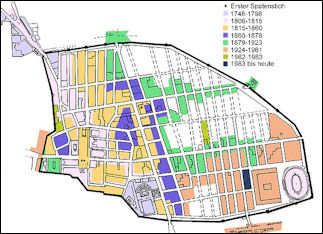
Plan of Pompeii Pompeii was first occupied by in the 4th century B.C. In the 2nd century B.C. most structures were modest houses and workshops. In the 1st century B.C. the town was bombarded by stone artillery shells by Roman troops. Later it became dominated by larger luxurious residences surrounded by by bars and shops. The first masonry residences appeared in the 3rd century B.C. A typical large villa began as a modest house and expanded as property around it was bought up and new wings were added around a courtyard,
Pompeii’s patron deity was Venus,, the Roman goddess of love and beauty, which might perhaps explain why the city was filled with so much erotic art. The catastrophic eruption of Vesuvius was not the only hardship the city endured. In 96 B.C. Pompeii was struck by a devastating earthquake. It was still being rebuilt when the A.D. 79 eruption occurred. The hardened, fine-grained ash and rock frtom that eruption proved to be an excellent preservative, encasing objects like insects in amber.
The ruins of Pompeii covers an area of 164 acres (about a fifth of the size of New York's Central Park) and is located within an irregular oval with a circumference of 2¼ miles. The ruins are scattered over a larger area but are not as well preserved as those of Herculaneum . Thus far about two thirds of Pompeii has been excavated (115 acres exposed out of a 164). Pompeii is surrounded by about two miles of city wall and consists of the remains of official buildings, temples, sumptuous villas, 500 smaller houses (many with ground-floor stores), a large amphitheater and two smaller theaters. There are at least three Roman baths in Pompeii and many of the city's houses had gardens that took up more space than the houses themselves.
The remains of 2,000 people have been found in Pompeii. Casts are scattered around Pompeii. A couple can be seen in the caged-off on the side of the Forum.
Major Features of Pompeii
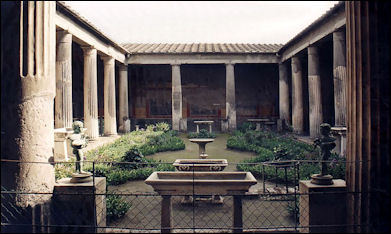
Casa de Vetti The Porta Marina Entrance (about 200 meters from the train station) is the main entrance for people entering Pompeii. It is so named because it was once located at the site of the main port and marina for Pompeii. Today Pompeii is about a mile from the sea. Near the entrance is the Temple of Venus and the basilica (law court). Across the main walkway from basilica is the Sanctuary of Apollo. It contains a column with a sundial and statues of Diana and Apollo (the originals are at the archeology museum in Naples.
The Forum (reached by an uphill walkway from the Porta Marina Entrance) was the main center of commercial and social activity at Pompeii. Long and narrow, it is surrounded by a colonnade. At the far end of the Forum to the left are the Forum Olitorium (Storehouses) a caged-off area of building pieces, pottery and artifacts. Inside this area are cases holding casts of some of the people who died at Pompeii.
Behind the Forum (next to Basilica) are municipal buildings. To the right of the Forum is the Comitium, Building of Eurmachia (with a carved door frame covered with images of animals, insects and scrolls), Temple of Vespian (with a frieze depicting a sacrifice) and Temple of the Temple of Public Lares.
Via dell'Abbondanza (the main thoroughfare between the Forum and the Great Plestra and Amphitheater) features political graffiti from Pompeii's last election, rude remarks about homosexuals and comments about love and conquest scribbled on the walls. One comment read, "Lovers like bees lead a honey-sweet life." Another read, "Resistus has deceived many girls."On the cobblestones one can ses large ruts made by chariot and cart wheels. The Stabian Baths (near the Lupanar on Vi. dell'Abbondanza) is a large public bath with its marble floors and stucco ceilings. The rooms include a men's bath, women's bath, dressing room, “frigidaria” (cold bath), “tepidaria” (warm bath) and “caldaria” (steam bath).
Businesses, Temples and Theaters at Pompeii
Lupanar (a couple of blocks away from the Forum) is an ancient brothel famous for its erotic frescoes and inscriptions. Each of the prostitutes worked in a stall with a stone platform-style bed (and today often a cat). Above the stalls are erotic frescoes that reportedly described the specialty of the prostitute who worked inside. Taverna Lusoria is a gambling house frequented by both men and women. Inscription mark loans given by the owner to his patrons.
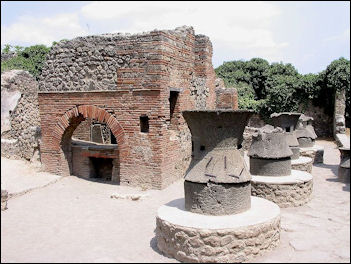
Pompeii bakery Thermopolium of Asellima is a bar where bronze cups, lamps and petty cash were found. Outside on a wall are scrawled the names of three women who presumably entertained guests in the cubicles upstairs; as well as the names of favored candidates in an upcoming election.
Temple of Jupiter (at the far end of the Forum) was mostly destroyed by an earthquake that struck 17 years before Vesuvius's catastrophic eruption. A marble relief depicts the A.D. 62 earthquake that struck Pompeii with skewed buildings and riders toppled off their horses. The Forum Baths (behind the Temple of Jupiter and the Cafeteria) features a body cast that has been chipped away reveling teeth and bone.
Amphitheater (east end of Pompeii) was large enough to accommodate 40,000 people. It was one of the first to be built specially for gladiator contest. Among the gladiators that fought there was Spartacus. A variety of helmets and weapons have been unearthed under the gladiator’s barracks along with the remains of a wealthy woman wearing lots of expensive jewelry, raising speculation that perhaps she died during the eruption while visiting a gladiator lover.
Large Theater (across Via dell'Abbondanza from the Stabian Baths) has seats for 5,000 spectators. Built in the 2nd century B.C., it was used for various kinds of entertainment, including gladiator battles and dramas. The gladiator barracks lie behind the stage. To one side of the Large Theater is the Little Theater, which staged dramas and dance performance. On the other side is the Triangular Forum and a Doric Temple. On the way to Via dell'Abbondanza are two excellent, well-preserved houses — the House of Secindu and the House of Meander — both with good frescoes.
Art and Artifacts from Pompeii
The artifacts unearthed at Pompeii have given archeologist valuable insights into everyday Roman life. Among the items that have been found are paintings, furniture, kitchen utensils and a bakery with 81 carbonized loaves of bread. There was lots of graffiti. Pompeii houses were mostly windowless. Their plaster walls proved t be inviting canvasses for people to express their written thoughts, some of which seem familiar today such as “Auge Loves Allotenus” and “Gaias Pumidius Dipilus was Here.”
Artistic pieces that have been unearthed include a gold bracelet of a two-headed snake that weighs half a kilogram; a silver wine goblet adorned with olives that hang off it like pearl earings; a bronze gladiator helmet sculpted with reliefs of women; a gold and silver statuette of Mercury with a small goat; and a finely-crafted necklace made of 94 ivy leaves made of gold foil. Most of these treasures are at the National Archaeological Museum in Naples.
Herculaneum
Herculaneum (15 minutes from Pompeii by train) was also destroyed by Vesuvius but was entombed deeper under a different, harder, material than Pompeii because it was closer to Vesuvius. It was buried under 20 meters feet of pyroclastic flows and very hot mud unlike Pompeii, which was buried under ash. The hardened material over Herculaneum is harder to dig but better at preserving stuff that the ash that entombed Pompeii. Perishable things wooden beds, fishnets, rope ladders, sacks of grain and a library of papyrus scrolls have preserved.
Herculaneum never knew what hit it. For a long time archeologist thought many of its residents escaped because less skeletons and entombed bodies were found here than in Pompeii. But it turns the opposite was true. Herculaneum was engulfed by a pyroclastic flow that swept down from Vesuvius before the major eruption even began. This avalanche of fiery gases and volcanic debris incinerated the bodies but left the buildings standing, sort of like what a neutron bomb is supposes to do. Successive flows covered the city with layers of material almost 70 feet thick.
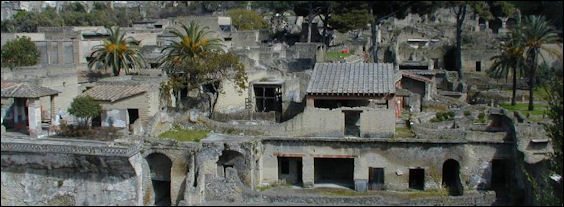
Herculaneum
Considerably smaller than Pompeii, Herculaneum was a wealthy seaside town with a population of 5,000 where fisherman and craftsmen mingled with rich nobleman and senators who came down from Rome and used the town as a retreat. The wealthy lived by the sea. Less prominent citizens lived away from the beach in smaller houses and craftsman and merchants slept above their shops on the main street,
The first part of Herculaneum discovered was the ancient 2,500-seat theater found by a well digger in 1709. Over the the decades archaeologists have unearthed entire pieces of furniture like wooden beds and marble basins as well as foodstuffs such as eggs, vegetables and chicken bones. Many of these items were badly charred but others, including a cloth press that operates the same as printing presses that came 14 centuries later, are in surprisingly good shape. Some of the rectangular houses with red tile roofs that you see don't look all that different from some of the houses in the modern town surrounds the archeological site.
Many artifacts and skeletons can be viewed in the Herculaneum Museum located next to archeological site. Tourists who have visited Pompeii will not find much new at Herculaneum. The remains are better preserved than those at Pompeii but the styles of frescoes and houses are very similar and there are fewer of them. About 20 houses are open to the public.
Herculaneum lies in a twenty-acre sunken pit 60 feet below the ground in the middle of the city of Ercolano. The seawall of the ancient city is situated a kilometer inland of the Bay of Naples, showing how much land the A.D. 79 eruption reclaimed. Visitors buy a ticket and walk down a road and pass through a tunnel to reach the excavations, which lie deep below the city of Ercolano. The entire site made of only about eight tightly-packed blocks.
Buildings in Herculaneum
Villa of the Papyri (500 meters west of Herculaneum) is a large mansion thought to have been owned by Lucius Calpurnius Piso, the father-in-law of Julius Caesar. Named for its immense library of scrolls, it contained a swimming pool more than 200 feet long and frescoes, mosaics and more than 90 statues. It was known as one of the grandest homes in the world. A blueprint of the building, drawn in the 18th century by a Swiss engineer, was used as a model for the J. Paul Getty Museum in Malibu, California.
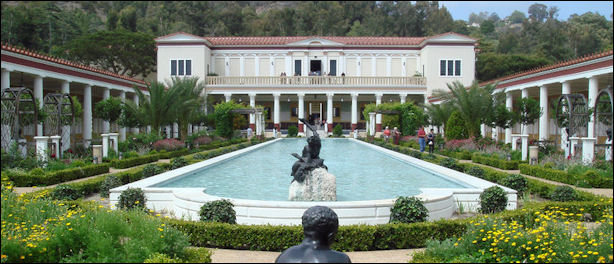
Getty Villa Museum (copy of Herculaneum's Villa de Papyri
The main floor is almost four meters below sea level. A poor excavation in the 1990s left, it flooded and overgrown with weeds. Now its is better shape. Pumps pump out the water. Some mosaics are visible. Among the items recovered have been damaged, but still legible, papyrus manuscripts, a fine marble statue of Hera, queen of the gods and a finely chiseled head of an Amazon warrior. Most of the villa's wonderful artifacts are displayed in the Naples Archeological Museum. Parts of the Villa de Papyri are open. But don’t expect a grand mansion. Just a few rooms are open.
The House of Stags (Herculaneum) boasts a pair of marble hunting statues featuring hunting dogs attacking a male deer in the courtyard. You can also see a the statue of a “Satyr and a Wineskin” and a statue of a drunken Hercules attempting to pee. The Suburban Baths (Herculaneum) is where The noblemen relaxed in indoor pools under skylights and wall paintings. The vaulted swimming pool and warm and hot baths are in excellent condition. The House of Mosaic of Neptune and Anfitrite (Herculaneum) features an extraordinary mosaic. The house was owned by a rich shop owner.
Samnise House (Herculaneum) has a mock colonnade made of stucco. The Atrium of Mosaics may be the most beautiful and well preserved structure at Herculaneum. It has a black white checkered mosaic floor and a balcony offering a beautiful view of the sea.Decumanus Maximus is Herculaneum's main street. Off the street is a large basilica where citizens to conducted business or sought justice.
The Sacred Area (below the main excavation at Herculaneum) is where ceremonies honoring their pagan Gods were held. Palaestra (in the Sacred Area) is where nobleman watched young athletes compete in wrestling, swimming and foot races. The Theater (outside Herculaneum) had 2,500 seats. Unfortunately not long afterwards it was discovered its multicolored marble facings were looted by Naples nobility. The most startling feature inside the theater today is the ghostly imprint of a face that appears on the ceiling of a tunnel. The image was made by a statue toppled into a soft volcanic flow. Unfortunately it is rarely open.
Ephesus
Ephesus (about 60 miles south of Izmir, Turkey) in Asia Minor grew into a great city under Roman rule. Called "the first and greatest metropolis in Asia" it was the home of 250,000 people and one of the first cities in the world to embrace Christianity. Even though it is located about eight miles inland today, Ephesus was once a great port and in its time the commercial hub of the Mediterranean and the place where St. Paul sent his letter to the Ephesians.

Nymphaeum of Trajan in Ephesus
Outside the entrance gate is a completely restored gymnasium, the Roman equivalent of a secondary school. The first place you come to inside the gate is a huge a 24,000 seat amphitheater where St. Paul spoke during the first century after Christ's death. After one of St. Paul's sermon's a riot broke out because the citizens of Ephesus feared that Christ would dethrone their popular pagan goddess Diana.
The Marble Way is road paved with flat stones. Heading up the Marble Way you pass the Library of Celsius, the most beautifully restored structure in Ephesus. The marble facade of the library is comprised of two tiers of Corinthian columns and niches with statues. If you are so inclined it is possible to crawl around in the ancient sewer system underneath the building.
Ascending from the library to the top of a hill is the Sacred Way, an ancient marble road lined with columns its entire length. Off to one side of the road is an ancient brothel, identified with a small inscribed foot and a woman with a mohawk haircut. As you climb up the hill you pass the sacred pump room which produced water that purportedly made sterile women fertile. Further up is the Fountain of the Trojans and the Temple of Hadrian. The later is adorned with friezes of elephants, warriors, kings and gods, and was used to worship the emperor.
Temple of Diana
The Temple of Diana (in Ephesus) was ordered by King Croesus and completed around 550 B.C. after 120 years of labor. Described by Phion as the greatest of the seven wonders, the Temple of Diana was 225-feet-wide and 525-feet-long, with 127 sixty-foot-high marble columns. The largest and most complex temple in ancient times, it was made out of marble, wood and tile, and built on marshy soil so it would be immune to earthquakes. Even so the temple had to be rebuilt three times before Goths destroyed it in 262 A.D.
The Temple of Diana was built around 550 B.C. near the sea and destroyed by invading Goths around A.D. 262. Ertastratus ordered the Temple of Diana to be burned down he did so to ensure that it was remembered, English archeologist J. T. Wood rediscovered the temple in 1874 after 11 years of digging. Today the ruins are located a mile or so away from Ephesus, and unfortunately all that remains is a foundation.
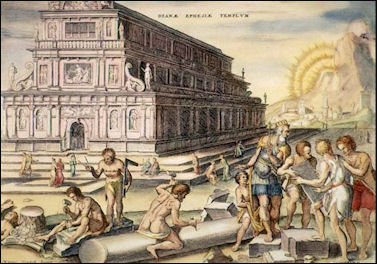
Temple of Diana in Epesus,
One of the Seven Wonders of the World Diana of Ephesus, also known as the virgin huntress of the moon, was worshipped throughout most of Europe and the Mediterranean during ancient times and she still has followers today. The Greeks knew her as Artemis, and her origins can be traced as far back as Babylon. She may even have evolved from Stone Age earth mothers goddesses that dominated primitive cultures before the Greeks popularized male gods.
Despite the fact she was a permanent virgin, she was the goddess of fertility, and the famous statue of her now in the Selçuk Museum has endowed her with 18 breasts. None of the breasts have nipples, however, which led one classical scholar to venture they were actually bull's testes or the ova on scared bees. Whatever they were Diana's image has fascinated artists for centuries. Other statues have placed bees on her knees and lions over her shoulders. A Raphael painting of her graces the Vatican. And recently a Brooklyn artist gave her four buttocks as well as a chestful of breasts.
What got St. Paul into trouble was his statement: "Diana should be despised and her magnificence should be destroyed" The Temple that honored her was a popular tourist attraction and silver souvenirs of Diana and her temple were sold on the streets of Ephesus like miniature Eiffel towers and Statues of Liberty are sold today. During the festival of Artemis images of Diana were placed on the steps of her temple for worshipers to kiss. [Source: Vicky Goldberg, New York Times, August 21, 1994].
Image Sources: Wikimedia Commons, The Louvre, The British Museum
Text Sources: Internet Ancient History Sourcebook: Rome sourcebooks.fordham.edu ; Internet Ancient History Sourcebook: Late Antiquity sourcebooks.fordham.edu ; Forum Romanum forumromanum.org ; “Outlines of Roman History” by William C. Morey, Ph.D., D.C.L. New York, American Book Company (1901), forumromanum.org \~\; “The Private Life of the Romans” by Harold Whetstone Johnston, Revised by Mary Johnston, Scott, Foresman and Company (1903, 1932) forumromanum.org |+|; BBC Ancient Rome bbc.co.uk/history/ ; Perseus Project - Tufts University; perseus.tufts.edu ; MIT, Online Library of Liberty, oll.libertyfund.org ; Gutenberg.org gutenberg.org Metropolitan Museum of Art, National Geographic, Smithsonian magazine, New York Times, Washington Post, Los Angeles Times, Live Science, Discover magazine, Times of London, Natural History magazine, Archaeology magazine, The New Yorker, Encyclopædia Britannica, "The Discoverers" [∞] and "The Creators" [μ]" by Daniel Boorstin. "Greek and Roman Life" by Ian Jenkins from the British Museum.Time, the BBC, Wikipedia, Reuters, Associated Press, The Guardian, AFP, Lonely Planet Guides, “World Religions” edited by Geoffrey Parrinder (Facts on File Publications, New York); “History of Warfare” by John Keegan (Vintage Books); “History of Art” by H.W. Janson Prentice Hall, Englewood Cliffs, N.J.), Compton’s Encyclopedia and various books and other publications.
Last updated October 2018

